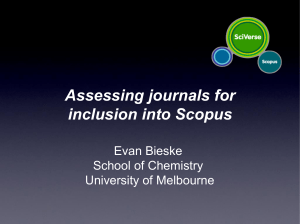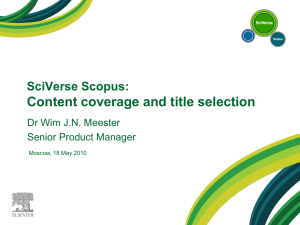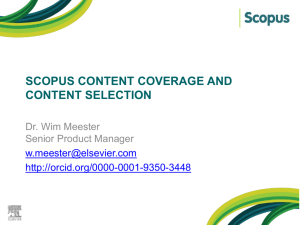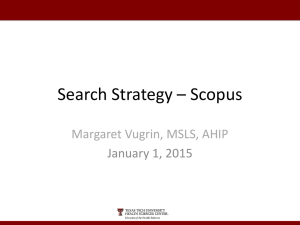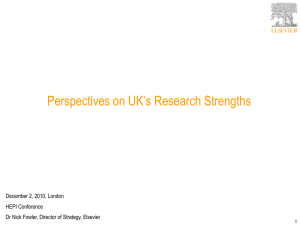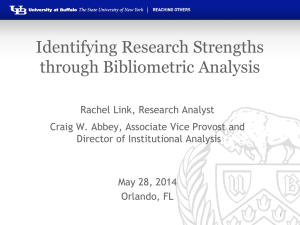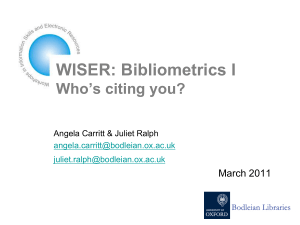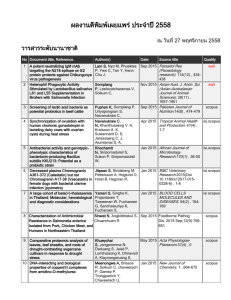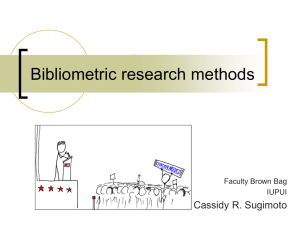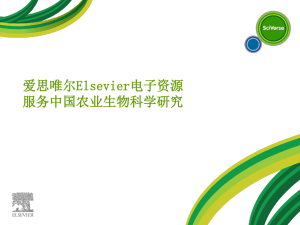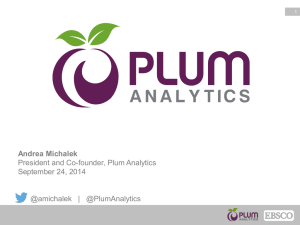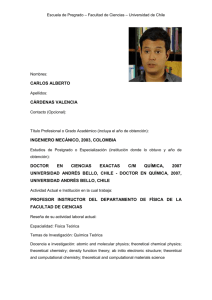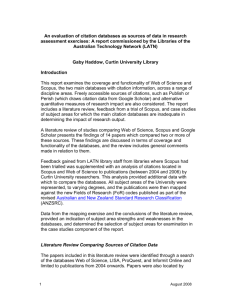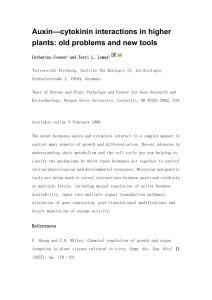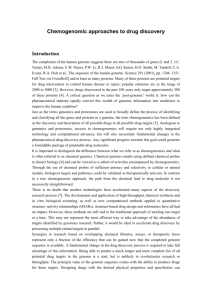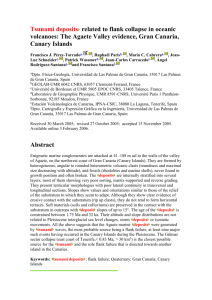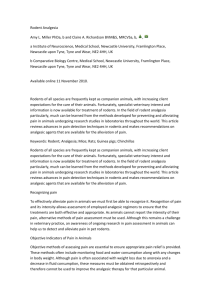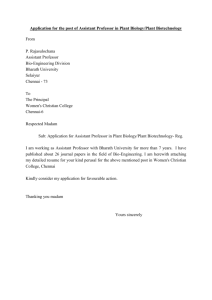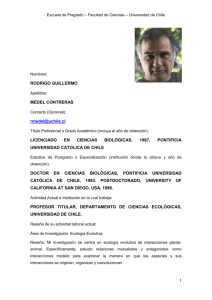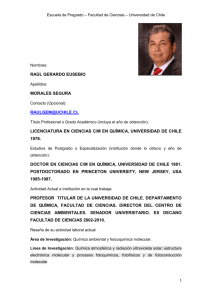Collaboration, Competition And The Global Drivers Of Research
advertisement
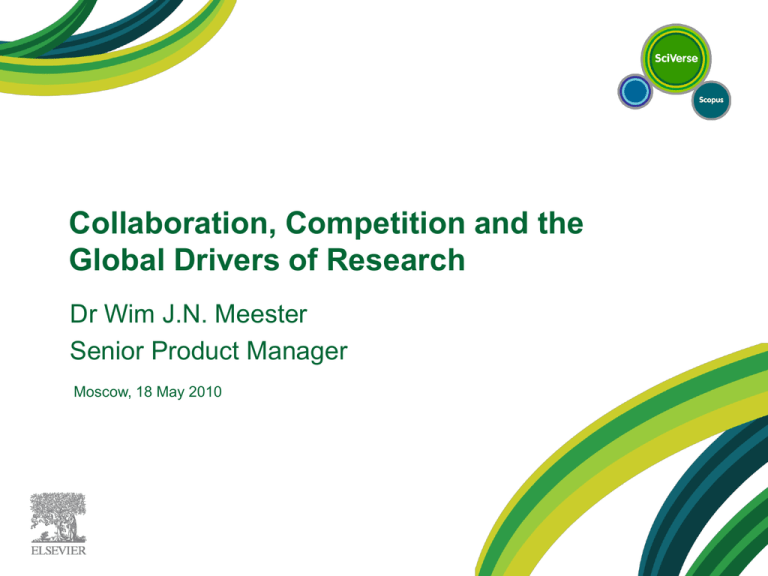
Collaboration, Competition and the Global Drivers of Research Dr Wim J.N. Meester Senior Product Manager Moscow, 18 May 2010 Science is growing globally Knowledge, networks and nations, The Royal Society, 2011 New global leaders are emerging Countries ranked by output growth 1997-2007 (percentage) “Today the dominant position of the United States in the international research and education community is being challenged as never before.” -American Academy of Arts and Sciences Sharing in science Scientists seek recognition for their work There is one character trait . . . which is an intrinsic part of a scientist’s culture, and which the public image doesn’t often include: his extreme egocentricity, expressed chiefly in his overmastering desire for recognition by his peers. No other recognition matters. And that recognition comes in only one way. It doesn’t really matter who you are or whom you know. You may not even know those other scientists personally, but they know you—through your publications. Driver of collaboration and competition Collaboration Competition Funding Personal loyalties Ideological, social and political forces Publish or perish Low-cost communication and travel Personal gain Funding Personal antipathies Ideological, social and political forces Publish or perish Drive for individual recognition Personal gain International collaboration rate International collaboration is rising globally 1996 1997 1998 1999 2000 2001 2002 Year 2003 2004 2005 2006 2007 2008 International collaboration is field-dependent International collaboration rate Numbers denote number of articles (thousands) in each subject area in 2008 International collaboration increases citation impact International collaboration leads to more citations Russia achieves more than three-fold publication impact increase by collaborating with ‘country x’ (in 2008) Who is looking at your research through Scopus? Rank Institution Country 1 2 3 4 5 6 7 8 9 10 11 12 13 14 15 16 17 18 19 20 University of Cambridge Harvard University Yale University University College London Massachusetts Institute of Technology University of Oxford Imperial College London University of Chicago California Institute of Technology Princeton University Columbia University University of Pennsylvania Stanford University Duke University University of Michigan Cornell University Johns Hopkins University ETH Zurich McGill University Australian National University UK US US UK US UK UK US UK US US US US US US US US Switzerland Canada Australia And in Russia How to use Scopus to promote your journal’s authors? Tools to increase collaboration based on Scopus content Evaluate research performance and make informed strategic decisions Tools to increase collaboration based on Scopus content Find experts and enable collaboration SciVerse Scopus: Content coverage and title selection Dr Wim J.N. Meester Senior Product Manager Moscow, 18 May 2010 7 million researchers worldwide 1,5 million research articles per year 3 articles published per minute “Average researcher is reading 300+ articles per year” “Researchers can spend up to 31% of time on content related activities” Scopus: Scanning the horizon for quality research Scopus: a broader view on Science Broadest source for research answers A rich and extended coverage including > 18,500 titles Abstracts and citations from > 5,000 publishers 4,4 Million conference papers (10% of Scopus records) “Articles in Press” from more than 3,750 titles 24 Million Patents 17,500 Peer reviewed journals 1,200 Open Access journals 80% of all Scopus records have an abstract Abstracts going back to 1823 40 languages covered 315 m integrated scientific websites via Scirus 400 Trade journals 300 Book series Breadth of coverage across subject areas Physical Sciences 6,350 Health Sciences 6,200 Social Sciences 5,900 Life Sciences 3,950 • Chemistry • (100% Medline) • Psychology • Neuroscience • Physics • Nursing • Economics • Pharmacology • Engineering • Dentistry • Business • Biology • etc., • etc., • A&H • etc., • etc., More than 18,500 titles in Scopus, titles can be in more than one subject area Breadth of coverage across geographical areas 1,050 5,950 8,700 1,600 400 500 350 Wider coverage gives a more accurate picture of the research landscape l Breadth of coverage Russia Number of documents in Scopus with Russian country affiliation in 2006 – 2010 Russian 187 Russian titles in Scopus Other language Publication types BioPhysical Engineering Social Humanities All Medicine Sciences Sciences Sciences Adding other content types in subject areas where it matters most Broader coverage than nearest peer Scopus (Total: 18,772) Web of Science (Total: 11,419) 8,234 10,538 881 “The Scopus surplus” www.jisc-adat.com Broader coverage means more citations In Thousands Nearest peer Scopus Scopus has on average 10% more citations per article >7,000 citations for these examples Number of citations to most cited articles in WoS and Scopus Broader coverage = higher citations Exponential growth of academic/scholarly journals 90000 80000 70000 60000 50000 40000 30000 20000 10000 0 <1900 1900s 1910s 1920s 1930s 1940s 1950s 1960s 1970s 1980s 1990s 2000s Active refereed serials Refereed serials Active serials All serials Ulrichsweb.com June 2010 And new global leaders are emerging 45 49 25 -6 35 63 48 22 10 80 204 25 5 505 50 366 98 126 159 76 Low growth rate High growth rate Countries by research output growth rate (%) 1997-2007 But these new leaders have relatively low citation rates 0.59 0.48 0.13 0.56 0.51 0.30 0.68 0.54 0.47 0.56 0.22 0.15 0.39 0.45 0.19 0.21 0.33 0.20 0.23 0.46 Low citation rate High citation rate Countries by average citation count in 2007 Quality selection by independent, international board Scopus new title suggestions http://www.info.sciverse.com/scopus/scopus-in-detail/content-selection Technical criteria Eligibility • • • • • Peer-review English abstracts Regular publication References in Roman script Publication ethics and malpractice statement Scopus selection criteria a combination of quantitative and qualitative measures Journal policy Quality of content Citedness Regularity Accessibility • • • • • • • • • • • • • • • • English language abstracts available All cited references in Roman alphabet Convincing editorial concept/policy Level of peer-review Diversity in provenance of editors Diversity in provenance of authors Academic contribution to the field Clarity of abstracts Conformity with journal’s aims & scope Readability of articles Citedness of journal articles in Scopus Citedness of editors in Scopus No delay in publication schedule Content available online English-language journal home page Quality of home page Scopus Title Evaluation Process Publisher Suggest Title Input Not for review Feedback decision Rejection + reasons N Check against pre-conditions OK for Review? Y Setup content feed Further enrich titles N Review title Make decision External Reviewer CSAB Y Top 25 countries suggested titles 2008-2011 1200 Under review Reviewed 1000 800 600 400 200 0 Not for review (n=6156) Top 25 countries reviewed titles (2011) 100% 90% 80% 70% 60% 50% 40% 30% 20% 10% 0% (n=232) Accepted Rejected Scholarly titles from the Russian Federation (20%) (13%) Suggested for review Under review by CSAB Not accepted for review Accepted Rejected Pro-active: Social Sciences and A&H comparison study ERIH (5,186) Francis (2,344) 1,200 AERES (5,116) Cairn (219) Comprehensiveness Adding Publishers’ archives (> 2,650 titles) Planned: Quality of content and Correctness This is an “article number”, not a Page Number New software is being installed to match citations for journals that use this publication method Tools to improve user experience Datasets Thank You Global competition has increased dramatically Countries ranked by published output (times 1,000 documents) 1997 2007 Scholarly titles from Spain (14%) (4%) Suggested for review Under review by CSAB Not accepted for review Accepted Rejected Local initiatives: FECYT (Spain) Excellent Scientific quality Formal quality Basic quality Pre-selection Collaboration between Brazil, Russia, India and China and the G7 (2004-2008) Thank You
